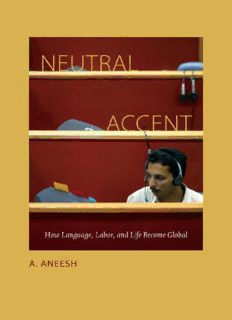
Neutral Accent: How Language, Labor, and Life Become Global PDF
Preview Neutral Accent: How Language, Labor, and Life Become Global
NEUTRAL ACCENT Duke University Press Durham and London 2015 NEUTRAL ACCENT How Language, Labor, and Life Become Global A. Aneesh © 2015 Duke University Press All rights reserved Printed in the United States of America on acid- free paper ♾ Typeset in Myriad Pro and Quadraat by Graphic Composition, Inc. Library of Congress Cataloging-in-Publication Data Aneesh, A. (Aneesh), 1964– Neutral accent : how language, labor, and life become global / A. Aneesh. pages cm Includes bibliographical references and index. isbn 978-0-8223-5846-6 (hardcover : alk. paper) isbn 978-0-8223-5853-4 (pbk. : alk. paper) isbn 978-0-8223-7571-5 (e-book) 1. Call center agents—India—Gurgaon. 2. Call centers—India—Gurgaon. 3. Globalization. 4. Intercultural communication. i. Title. he8789.i4a54 2015 381'.1—dc23 2014046257 Cover art: bpo, Bangalore, Kamataka, India. Photo by IndiaPicture/uig via Getty Images. FOR ELIJAH, until the last breath and after CONTENTS Acknowledgments ix Prologue: One World, Diverse Itineraries 1 1 Glimpsing an Urban Future: Divergent Tracks of Gurgaon 13 2 Inside a Call Center: Otherworldly Passages 35 3 Neutral Accent 53 4 System Identities: Divergent Itineraries and Uses of Personality 77 5 Nightly Clashes: Diurnal Body, Nocturnal Labor, Neutral Markets 101 Epilogue: The Logic of Indifference 127 References 137 Index 151 ACKNOWLEDGMENTS Had I not taken half a dozen years to complete this book, I would have pre- vented names from slipping through the cracks in memory, and I will not have to face the anxiety of ingratitude. Perhaps I needed to start an acknowl- edgment section before starting the manuscript, as debts began to accumu- late long before the manuscript took shape. Now I succumb to the cheap trick of apologizing to those whose help, though scattered through the pages ahead, remains unacknowledged. Let me begin by thanking the MacArthur Foundation for funding field research in India, including research assistance, equipment, and all other expenses during 2004–5 (Grant No. 03–80081–000- gss). I also thank two research assistants, Sabil Francis and Rosmin Matthew, who were graduate students at Jawaharlal Nehru University at the time, and partners in research. A couple of years later I was fortunate to receive a resident fellowship at the School for Advanced Research (sar) in Santa Fe, allowing me to reflect back on field research, analyze the material, read a lot, and write a bit. I felt deeply supported by the sar’s president at the time, James Brooks, and his sociolo- gist wife, Rebecca Allahyari, who made critical comments and suggestions on early presentations and writing. I must also thank my colleagues at the sar— Graham St. John, Barbara Rose Johnston, Eric Haanstad, Noenoe K. Silva, Julie Velasquez—whose intellectual and gastronomical companionship was crucial to that magical year of contemplation and New Mexican cuisine. Had I concentrated less on eating out in Santa Fe, I would have probably completed
Description: